
The bill, which received strong bipartisan support, is titled the Weather Research and Forecasting Innovation Act of 2017, H.R. 353. It was passed in the House of Representatives in January and was approved by the Senate on March 29.
The legislation authorizes the National Oceanic and Atmospheric Administration (NOAA) to prioritize research to improve weather data, modeling, computing, forecasting and warnings to better protect lives and property.
The Weather Research and Forecasting Innovation Act is a major step toward more accurate and timely weather predictions, said U.S. Rep. Frank Lucas, a Oklahoma Republican, the bill's sponsor.
"When a major storm or tornado is quickly approaching your community, every additional minute of preparation time counts. This legislation strengthens our country's commitment to severe weather forecasting and ensures NOAA has access to the best weather data," Lucas said.
AccuWeather CEO Barry Lee Myers called the bill a "monumental piece of legislation."
"It's a significant milestone for the whole weather enterprise," Myers said. "It's the first time that there has ever been a piece of federal legislation in this field that works to bring NOAA, the research community and the weather industry together in various ways."
Part of the research that will be conducted by NOAA will emphasize high-impact weather events such as improved tornado warnings and hurricane forecasts to the public.
Last October, when Hurricane Matthew was barreling through the Atlantic, one of NOAA's Hurricane Hunter planes that was scheduled to fly over the hurricane was grounded for repairs and never flew. The opportunity to gather information about the storm was lost.
"That was a concern for a number of people, and there's provisions now in the bill to make sure that there's sufficient backup, for example, to make sure that all the data that needs to be available is available," Myers said.
Other aspects of the legislation specify that the National Weather Service (NWS) must collect and utilize information to make reliable and timely foundational forecasts of subseasonal and seasonal temperature and precipitation.
Subseasonal forecasting is classified as forecasting weather between two weeks and three months, while seasonal forecasting is between three months and two years.
With the bill now signed into law, it allows for technology transfers between the National Weather Service, private weather companies and universities to improve forecasting. It will also give NOAA the capability to contract with the weather industry to obtain data for weather forecasting.
U.S. Rep. Lamar Smith, a Texas Republican and one of the bill's cosponsors, said forecasting will be improved by looking to the weather industry for new technologies and weather solutions.
"With this bipartisan effort, we will improve forecasting by looking to the private sector for new technologies and weather solutions," Smith said. "This bill gives NOAA a clear vision and allows them the flexibility to buy new, affordable and potentially better sources of data."
The Weather Research and Forecasting Act is the first piece of weather legislation enacted by Congress since 1992.
Myers, who has testified numerous times in front of Congress to explain why the weather enterprise needs to work together and why the bill is so valuable, called it a "lifetime of work."
The American Meteorological Society (AMS), the American Weather and Climate Industry Association (AWCIA), the University Corporation for Atmospheric Research (UCAR) and a number of companies emphasized the bill's vital importance to legislators.



Reader Comments